Welcome back to our journey through and ranking of all 20 films directed by the legendarily prolific auteur, comedian, artist, and all-around TV personality Kitano “Beat” Takeshi. You can read the beginning of the ranking here; our last article covered his least-beloved comedy film, his trilogy of surreal self-reflexive “biographical” films, and two of his three Outrage yakuza films, alongside a recent format-bending send up of that same series. Now, with his seven lowest-ranking films out of the way, it’s time to move on to bluer skies with Takeshi’s more successful outings!
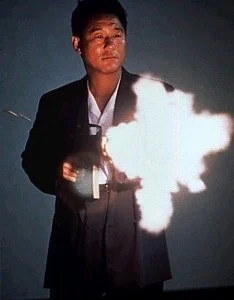
Table of Contents
Toggle#13: Dolls (2002)

Dolls is a very unique outing for Takeshi; a three-story film about love and regret, presented as something of a modern bunraku tale, only replacing the puppets of that traditional Japanese theatrical art with live-action human beings.
Takeshi’s previous film, the international flop Brother, was perhaps a signal that Takeshi’s tried-and-true series of hard-boiled crime films was running on fumes. The result is another hard left away from his standard stylings, and is not only his first film in which he doesn’t personally appear since 1996’s Kids Return – it’s also a departure from his until-now mostly grounded filmography.
The first part of this triptych stars a late-20s Nishijima Hidetoshi, recently of Oscar-nominated Drive My Car fame. This is the primary story of the film, focusing on a regretful lover who runs off with the woman he left for better prospects following a suicide attempt that leaves the woman mentally diminished. It’s quiet, slow, and serious, and features some memorable imagery thanks to cinematographer and frequent Takeshi collaborator Yanagishima Katsumi. The score – the final in the long series by Hisaishi Joe for Takeshi – is suitably elegiac.
As the film continues, two more stories emerge: one about the lost love of an aging yakuza boss, and the other about an obsessive fan’s reaction when the object of his fandom is injured in a car accident. (This last story has a bit in common with Kon Satoshi’s famous Perfect Blue, although this is a much gentler tale.)
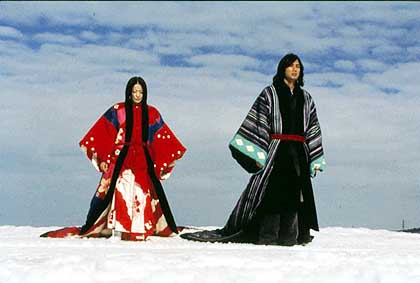
Takeshi’s Beautiful Puppets on Red Strings
Unlike most of Takeshi’s second-tier films, many of which are near-forgotten, Dolls does have its fans. Its patient stories of love and regret have a certain power. These tales are certainly old-fashioned – thematically melodramatic, despite the restrained nature of their presentation. That melodrama becomes more palatable as the film begins to shift into a more folkloric tone, where the connection between the love stories and old bunraku plays becomes clearer. The slight intersections between the stories help to maintain some interest as well.
There is something very intriguing about placing stories that feel so folkloric in a modern setting. It’s a bit disconcerting; it makes the extreme nature of the character’s life-changing decisions seem a bit silly, or even frustrating. These are also all stories where the male character is generally the one with agency, and the female character is more of a love object. But accepted for the type of stories these are – emblematic, rather than literal – there is something beautiful about them.
Among Takeshi’s filmography, Dolls has the most in common with A Scene by the Sea from a decade earlier, both being near-wordless mood pieces without Takeshi personally appearing. Both are certainly too slow and understated for many viewers to really appreciate. Those that do like these films will appreciate A Scene by the Sea for its slice-of-life aspects, or prefer Dolls for its cinematic beauty and somewhat dreamy qualities. For me, they both sit pretty firmly in the “good, not great” Takeshi tier. Both are certainly worth a watch for viewers with a bit of patience to spare.
Takeshi, as usual, doesn’t seem to care too much what others think about the film. He’s quoted as saying: “This is a truly personal film, so I don’t care if it’s a hit. It’s like when you’re overjoyed drawing something; creating ceases to have any connection to how the creation is received. I’m fine if it comes out poorly and people don’t want to see it. There’s just some movies you want to make.” This seems to apply to most of his movies, and is essential to understanding his unique attitude towards creation.
#12: Brother (2000)

Throughout the 1990s, Kitano Takeshi was presented with an interesting quandary. Despite being such a massive media figure in his home country, as a filmmaker, his movies were finding a more devoted and appreciative audience abroad. This was mostly on the film festival and art house circuit, but he must have felt there was potential for a real breakout hit if he turned his focus directly towards Hollywood. The end result is 2000’s Brother, a perfectly misguided endpoint for early-stage Takeshi.
The film co-stars an especially taciturn Takeshi opposite recognizable American actor Omar Epps, with a plot laser-targeted for cringe: Takeshi is a yakuza enforcer forced to flee Japan, hiding out with his younger brother’s mostly African American gang in Los Angeles. There, Takeshi quickly takes on a leading role in the gang, using his more formalized gangster skills and brutality to expand the gang’s territory. (Basically, he’s showing the Americans how it’s really done – as though gangs in the US don’t know how to use violence to their advantage.) This leads to numerous racialized showdowns between Takeshi’s adopted gang, other African American gangs, Latin American gangs, and finally the Italian Mafia.
Racial epithets fly almost as often as the gang war bullets. With this being a film written and directed by someone with only tangential experience of America, its crime scene, and multiethnic cultural framework, you can imagine how awkwardly much of this plays out on screen.

Oh, Brother – Is this Beat Takeshi’s The Room?
The thing, though, is that Brother is so misguided and so awkwardly presented (with a mix of Japanese and English dialogue and acting that ranges from competent to outright ridiculous) that it loops around to being one of Takeshi’s funniest films. It’s his only bad movie (of which he has more than a few) that really earns the coveted so-bad-it’s-good label. Takeshi’s worst films are really best avoided by anyone other than mega-fans; Brother, though, could make for a great midnight movie, Best-of-the-Worst style rotation. It’s got it all: bad acting, incredibly awkward portrayals of American race relations from an outsider’s perspective, ridiculous dialogue, and unforgettably cringey one-liners. It also has the innate fascination of the best bad movies; the “why did this get made,” the “what was the filmmaker’s perspective” questions that come to mind when viewing something as audaciously transnational as this movie.
Brother is unintentionally hilarious, and that makes it very hard to rank in a list like this. As a lover of good-bad films, Brother is in my top ten for Takeshi movies in terms of rewatchability. And as strange as it is to say, despite all its risible flaws, it’s still a better film than most of his mid-career movies; it still has beautiful pre-digital cinematography and that old-school sense of Takeshi style left over from his 90s period. Plus, it has another great Hisaishi Joe score! (Which, of all things, resembles a jazzier version of his score for Spirited Away.) So, if you’re looking for something fascinatingly bad and very watchable, Brother is by far the best of Kitano Takeshi’s worst.
#11: A Scene at the Sea (1991)
あの夏、いちばん静かな海
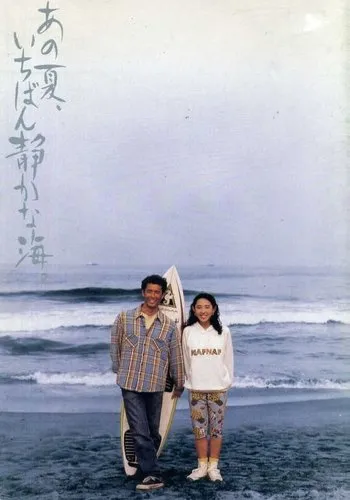
Only three films into Takeshi’s early filmography, and here we have his first foray away from his bread-and-butter street violence. Instead, A Scene at the Sea is a gentle story about a deaf couple living in beachside Kanagawa Prefecture. After discovering an abandoned, broken surfboard on his garbage truck route, the boyfriend (played by real-life surfing champion Claude Maki) attempts to learn to surf.
The film takes the slice-of-life elements from Takeshi’s second film, Boiling Point, and allows them to exist without the constant threat of blow-out gun fights. With its unique viewpoint characters, both of whom are deaf, it’s also a film that forsakes much in the way of dialogue. It’s also Takeshi’s first film where he stays solely behind the camera. As such, your mileage may vary.
The Hisaishi Joe of it All
There’s one major addition here to the Takeshi arsenal: Hisaishi Joe has finally arrived to score the next decade’s worth of the director’s films. From the instant his elegiac synth starts playing over our MC attempting to fix his foundling surfboard, something shifts. Hisaishi’s score brings a completeness to Takeshi’s minimalist scenarios and restrained cinematography. The staid faces of his characters going about their daily life become soulful. We feel a yearning, a hopefulness; we feel a greater depth to the plainly presented world around them. With Hisaishi’s arrival, Takeshi’s films finally feel whole.
When Takeshi’s team reached out to Hisaishi, he’d already seen Violent Cop and Boiling Point, and liked both; however, he thought his style wouldn’t match Takeshi’s filmmaking. When he refused, Takeshi said he’d wait a full month for Hisaishi to reconsider – this impressed the composer enough to convince him to come aboard. The result is one of Japan’s most fruitful director-composer relationships. (Or at least it would be until 2002 – but that’s a story for another movie.)
The music is a third star of the film alongside the smiling couple featured on the theatrical posters; The couple is already together as the film begins; they head off to the beach, the girlfriend gently grasping onto the MC’s surfboard as he strides ahead. It’s a sweet scene, buoyed by Hisaishi’s theme.
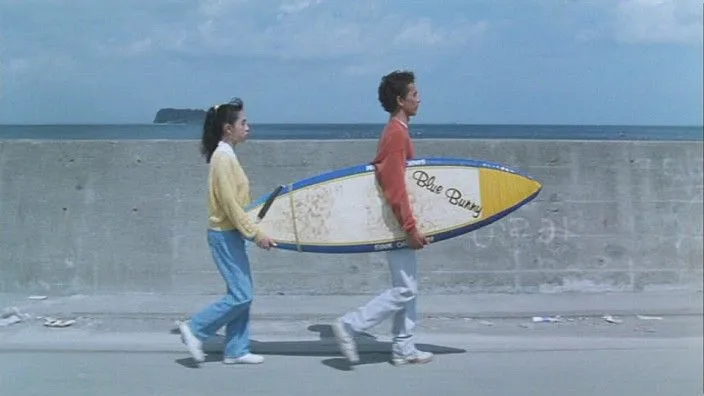
Still Life
Takeshi’s interest in the mundane realities of Japanese urban life has been apparent since his first film. With A Scene at the Sea, those interests are fully fleshed out. Violent Cop was a film about cops and yakuza; Boiling Point about yakuza and civilians. A Scene at the Sea is just about civilians. It has a human warmth, too; it’s about two people who care about each other, after all. It’s a sweet, slow, quiet film. And combined with the beautiful cinematography of early-90s Kanagawa and Hisaishi’s relaxed, dreamy score, it’s a real vibe.
Planning a trip to Japan? Get an authentic, interpreted experience from Unseen Japan Tours and see a side of the country others miss!

"Noah [at Unseen Japan] put together an itinerary that didn’t lock us in and we could travel at our own pace. In Tokyo, he guided us personally on a walking tour. Overall, he made our Japan trip an experience not to forget." - Kate and Simon S., Australia

See a side of Tokyo that other tourists can't. Book a tour with Unseen Japan Tours - we'll tailor your trip to your interests and guide you through experiences usually closed off to non-Japanese speakers.


Want more news and views from Japan? Donate $5/month ($60 one-time donation) to the Unseen Japan Journalism Fund to join Unseen Japan Insider. You'll get our Insider newsletter with more news and deep dives, a chance to get your burning Japan questions answered, and a voice in our future editorial direction.
Unfortunately, the vibe gets a bit too quotidian as the movie becomes more about surfing and less about the relationships. Towards the end, there’s a surfing competition filmed in near-public-access documentary style, where Takeshi’s restrained directorial flair really pushes into “shoot-the-rodeo” style boredom. The last few minutes are also likely to frustrate some viewers, even with a great final montage and Hisaishi’s emotional score.
In the end, A Scene at the Sea is a strong early outing for Kitano with a unique viewpoint. It’ll likely touch some viewers in a way his more violent fare very much doesn’t. Some moments offer a transcendent view of the beautiful mundane that really makes the film worth watching – while others are a bit on the monotonous side. Overall, a good, but not quite great, film from Takeshi, that nonetheless contains some elements of greatness.
#10: Beyond Outrage (2012)
アウトレイジ ビヨンド
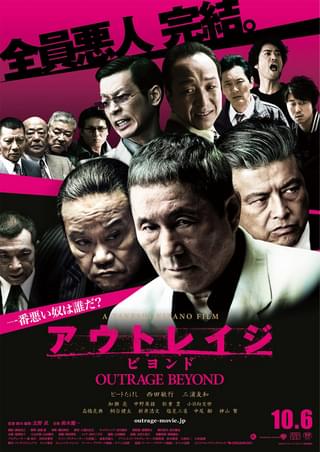
In 2012, Takeshi released his first-ever direct sequel, coming out right after his yakuza blood-fest Outrage proved to be a hit.
Beyond Outrage (Outrage Beyond in Japanese) is one of those sequels that can only exist by hand-waving the ending to the original. Even the film’s posters give away that the rather final ending of the last film is being rewritten. Thankfully, Takeshi’s character, Otomo, starts out more interesting than the near-cipher he was in the previous film. He’s regretful and unwilling to enter into a gang war when prompted. He’s aware of the game being played. His more interesting position within the film is just one way in which this sequel emerges as something better than expected.
Beyond Outrage starts out a little more restrained than the original, and the set-up is certainly more intriguing. Instead of plots-within-plots of interchangeable yakuza baddies looking to betray one another, this time we have an outside force – the police – looking to start trouble. As a corrupt cop tries to get a reluctant Otomo involved, we actually have characters with some interesting motivations, and a plot that’s much easier to follow and invest in.
It’s also a more focused film, without Takeshi’s usual meanderings or plot cul-de-sacs. Part of the joy of Takeshi’s best films are these little freewheeling asides, but for a more straight yakuza film like those of the Outrage trilogy, this tighter structure is appreciated.

When Viewed From Lived Experience…
Now, I like this movie, even though it sits at halfway down this ranking. Former vice-beat journalist and real-life yakuza expert Jake Adelstein (of Tokyo Vice fame), however, has told me that this is among his favorite Takeshi films. He prefers its gritty style and extreme bloodletting. Like the first Outrage, it also reveals some of the complexities of the yakuza; in this case, the multiethnic nature of crime organizations in Japan, and the power of ethnic Korean yakuza groups.
This is what Jake had to say about Beyond Outrage, and the series as a whole: “ The first two films in the series captured the brutality, pathology, and the real reality of the modern yakuza and their interactions with society and the police better than any yakuza film has ever done. The tagline for the first film was that they are all bad guys. But you will discover there’s a difference between bad guys with honor and those with none at all. I am in the minority, but I believe that it is his best work and maybe some of his best acting.”
Themes of police corruption are interlaid in Beyond Outrage too, with a memorable quote: “Cops get involved in sex scandals. They’re no different from yakuza.” We also get enjoyably cynical scenes of police berating a yakuza patsy for his poorly thought-out cover story. The movie also has one or two memorably creative kills; possibly the thing the series is best known for. (The really gruesome violence only pops up a few times, helping maintain the feeling of relative restraint here.)
The least interesting part of the film is the inevitable series of interchangeable shootouts between barely discernible yakuza mooks. Thankfully, interest picks up again in the final twenty minutes, mostly thanks to the aforementioned characters that this time are actually worth caring about. This helps make Beyond Outrage a much more even and overall enjoyable film than its predecessor or successor; while some of that enjoyment is enhanced by knowing the returning characters, this is a movie that surpasses the first in every way save for inventive kills.
Beyond Outrage is a competent, enjoyable yakuza film. It’s shockingly focused for a Takeshi movie as well. In the end, it’s the best thing to come out of his Outrage trilogy, even if it’s not fully in his top tier of films.
#9: Kids Return (1996)
キッズ・リターン
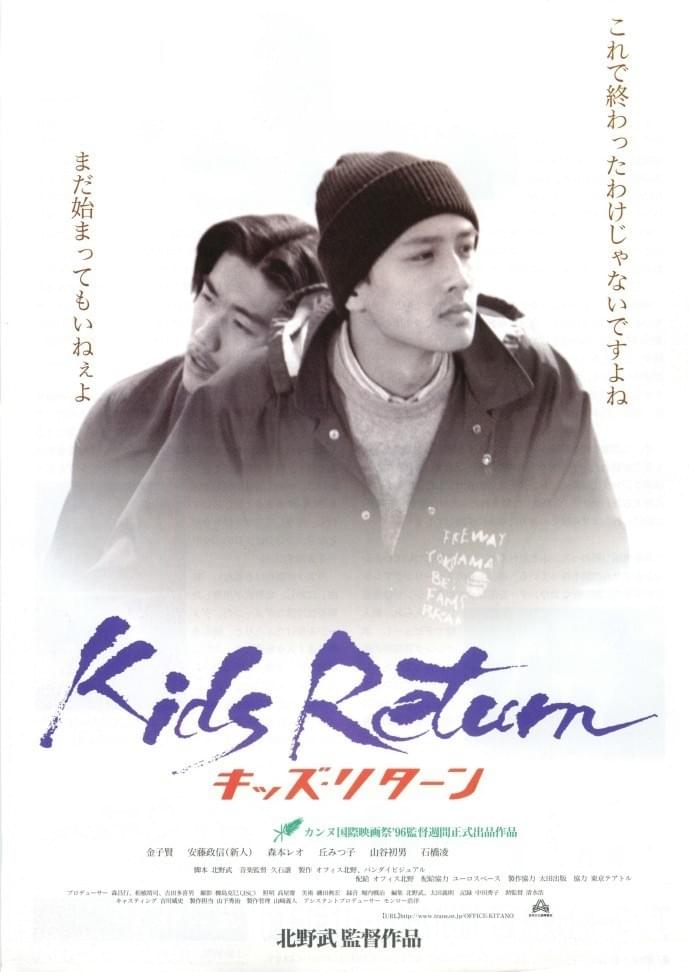
Back in 2011, shortly after the devastating March 11th earthquake and tsunami triple disaster, composer Hisaishi Joe announced a series of benefit concerts to raise money for children in the affected areas. Proceeds from the concerts would go towards replacing instruments that local children had lost in the calamity. I was a college student here in Tokyo, reeling from the effects even in the far-away capital; with Hisaishi as my favorite film composer, this seemed like a wonderful opportunity to help some of those affected while finally seeing him in concert.
(Little did I know that within two years I’d be sent to Fukushima Prefecture as an English teacher, becoming much better acquainted with the aftereffects of that disaster.)
The benefit concert was an amazing experience, with clips from the films he’d scored being projected behind Hisaishi as he alternatively conducted his orchestra and sat down to play his piano. Much of the music played was from his familiar work for Studio Ghibli‘s Miyazaki Hayao, but around half of the pieces were wonderfully new to me. And the one that stood out the most was his theme from Kitano Takeshi’s Kids Return, a movie I’d never even heard of before.
Hisaishi’s theme for this film is elegiac, propulsive, large-scale, tragic, and hopeful in turn. It’s very “Hisaishi Joe,” but still somehow unique amongst his massive catalogue of music. It’s one of my favorite themes he’s ever done, and I’ve always wanted to watch the Takeshi film it comes from. So, does the film Kids Return live up to that incredible musical theme?
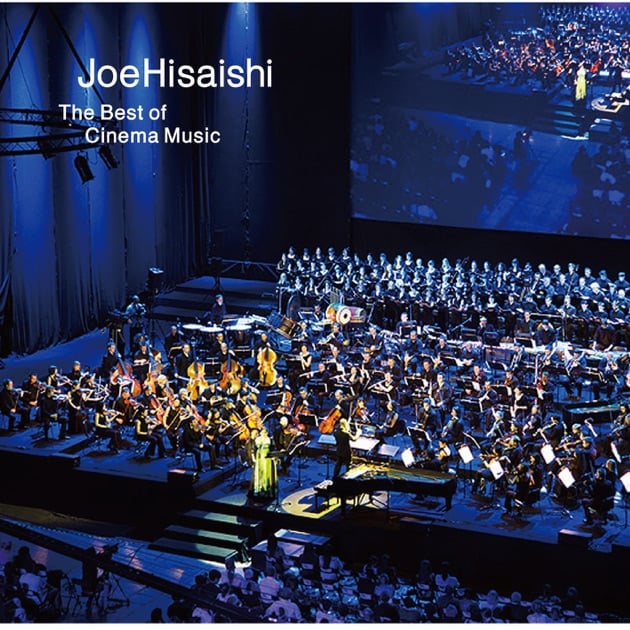
Sympathy for Mr. Bully
For much of its run, I’d say not quite. It’s not for lack of an interesting premise: Masaru (Kaneko Ken) and Shinji (Ando Masanobu) are two high school delinquents, considered hopeless by their teachers and the world around them. Masaru is the more vicious of the two, with Shinji relying on his tougher friend. But when their bullying of other classmates gets them embroiled in a light feud with a student boxer, it turns out Shinji is naturally gifted at the sport – and the two begin down opposite paths, one to sport, and one to crime.
Takeshi is unflinching in his depiction of these delinquents: they’re economically disadvantaged, but that doesn’t mean they’re just misunderstood kids. They’re bullies. Sadly, it’s a little hard to feel compassion for our protagonists when we see one of them beating classmates in public until they fork over whatever cash they have on them; stealing love letters to mock a young student with a crush; even throwing a dart into a classmate’s head. Essentially, they’re your classic schoolyard menaces, delinquents who love to see others suffer. This is pretty unpalatable, especially as the core story seems to focus on a bully training in boxing to become a better bully.
This means there’s a bit of thematic discord between the usual down-on-their-luck, coming-of-age sports framework of the film and the cruelty of the main characters. Boxing films don’t need sympathetic characters – not everyone needs to be a Rocky. Raging Bull, one of the best films of all time, is about a thoroughly reprehensible protagonist. But our main duo here can’t hold a candle to Jake LaMotta. (Not that it’s fair to compare these fine young actors to De Niro.) It doesn’t help that the main character, Shinji, is essentially a cipher beyond his relationship with the other punk.

In this Film, it’s Takeshi Who Truly Returns
On the other hand, Takeshi’s real-life experience growing up in poor areas of Tokyo helps ground this film with some real societal interest. It’s no surprise that kids like these drift towards the yakuza. In the 1990s, joining up with organized crime was still very much a pathway for young toughs with little promise. (Takeshi has even reminisced that during his childhood, “…there were two types of people that were considered cool: professional baseball players and yakuza.” [3] Before making Kids Return, Takeshi had just survived a motorcycle crash that nearly killed him – perhaps it left him thinking about his past.) There’s also a theme about uninterested teachers and kids who are given up on. The school system is cold and uncaring. The school’s reputation and the pupils’ ability to take standardized entrance exams is placed above their personal well being.
Planning a trip to Japan? Get an authentic, interpreted experience from Unseen Japan Tours and see a side of the country others miss!

"Noah [at Unseen Japan] put together an itinerary that didn’t lock us in and we could travel at our own pace. In Tokyo, he guided us personally on a walking tour. Overall, he made our Japan trip an experience not to forget." - Kate and Simon S., Australia

See a side of Tokyo that other tourists can't. Book a tour with Unseen Japan Tours - we'll tailor your trip to your interests and guide you through experiences usually closed off to non-Japanese speakers.


Want more news and views from Japan? Donate $5/month ($60 one-time donation) to the Unseen Japan Journalism Fund to join Unseen Japan Insider. You'll get our Insider newsletter with more news and deep dives, a chance to get your burning Japan questions answered, and a voice in our future editorial direction.
Still, using the worst delinquents to make this point isn’t all that inspiring. (And plus, it’s well worn territory in Japanese media. I’ll take my Urameshi Yusukes and Kuwabaras from Yu Yu Hakusho over these two.)
But, it turns out, much of the discomfort (or frustration) stemming from this dramatic tension is worth it. In it’s last portion, the different paths these two have chosen come in contact. Their relationship is thrown into a different light; they now exist in the separate milieus of sports and crime. It’s clear, however, that they still care for each other. In the last moments of the film, as Hisaishi’s score wells up around the two main characters, and we see all they’ve gone through, and the hard road they still have to go down, everything finally clicks. It’s one of the most meaningful endings Takeshi has ever made, up there with his best; and Hisaishi’s score is big part of why it works. This ending saves this film, making something unpalatable suddenly meaningful.
So I’m still unsure how I feel about the film as whole; but, with that ending in mind, it’s certainly one of the Takeshi films I’m most interested to revisit. And I’ll always have that soundtrack…
#8: Violent Cop (1989)
その男、凶暴につき

In 1990, Kitano Takeshi’s first directorial outing emerged in a shockingly fully formed state. When going through directors’ filmographies, first films are usually very hit-or-miss: Kubrick’s Killer’s Kiss (1955), Kurosawa’s Sanshiro Sugata (1943), and Scorcese’s Who’s That Knocking at My Door (1967); all show promise and a few discernible aspects of eventual directing trademarks. They’re also all far from the heights those directors would eventually reach. Violent Cop is different; it’s everything you’d expect from Kitano, boiled down to his usual components. There’s an assuredness here – Kitano comes into his directorial life somehow fully formed. You’ve got the silences, the long shots, and the sudden bursts of violence. Self-destructive characters hurtling towards implosion.
This is all the more impressive given that Takeshi was never meant to be the director. Instead, he was cast as the lead, and the movie was slated to be more outwardly comedic. A mix of disagreements with the original director (the legendary Fukasaku Kinji), and scandal over Takeshi breaking and entering a muckraking magazine he had beef with and physically roughing up the journalists, led to the near-shelving of the film; instead, the producers instructed Takeshi to take up direction. He did so on the condition that he be allowed to completely rework the script. It’s a miracle the film, and his directorial career, exist at all.
Violence Begets Violence, Donchaknow
Kitano’s filmography begins with a scene of senseless violence breaking through a peaceful evening. It’s a very promising start, full of beautiful shots of aging infrastructure and busy shitamachi downtown streets. A gang of school-aged toughs assault a homeless man in a park for fun; shortly thereafter, Takeshi, the titular “Violent Cop,” makes a call at the ringleader’s family home and proceeds to beat the schoolboy until he promises to turn himself in. It’s shocking, and wickedly satisfying. A great moment in Takeshi’s filmography, the movie never quite reaches that high again.
Takeshi plays the prototypical devil-may-care, throw-the-book-out police officer who uses violence to punish the guilty. As a Takeshi character, though, he’s even morally grayer than that. He’s a bully and a gambler, and incredibly touchy about the subject of his mentally disturbed sister. Like many Takeshi characters, he’s basically a charming sociopath. (And the plotline with his sister may be especially upsetting to some viewers.)

Hitting the Ground Running
Something that immediately stood out to thoughtful viewers in 1989 was the way Takeshi treats the police force; they’re far from heroes. The cops act stoic and tough, but are just as easily overwhelmed and at risk as the punks they brutalize. For Jake, this realism was a major appeal when the movie first came out: “The police’s use of language was so accurate; the way they moved, too. I really loved that.”
Discussion of Violent Cop often focuses on how Takeshi wanted to make a serious film in place of the original comedic version; this is interesting, because the film still has plenty of his classic deadpan. For a while, the movie is quite funny – if in a very dark sense – until it suddenly really isn’t.
The increasing violence shocks the film out of its humorous reverie. One of the most remarkable features of the film is the portrayal of the randomness of violence at its height – people become the sudden victims of violence not intended for them; after they suffer irreparable harm, these same victims are never spoken of again. Life moves on, until the next violent outburst. And who knows who the next victim will be, intended or unintended. It’s a stark thing, and a great sign of Takeshi’s unique viewpoint and themes already taking hold.
Still, the film is a bit too slight. Takeshi’s meandering pace and sudden tonal shifts are part of his appeal; here, though, we don’t quite have the emotional depths or situational interest to bring it all together. What we do have, though, is that beautiful shot-on-film cool that simply oozes the Takeshi style. This is a very worthwhile film to get to know Takeshi, but he’d only evolve from here.
#7: Boiling Point (1990)
3-4×10月

With a Japanese title that’s amongst the most difficult to remember or explain (what exactly is “3-4 x October” supposed to mean?), Boiling Point is the second slice of surrealist cinéma vérité from Takeshi. His second directorial outing feels more like a complete film than Violent Cop, although in a way that’ll likely turn many off his films rather than further their intrigue. It’s got some particularly objectionable interactions that will likely cross the line for some viewers. But it’s also a highly intriguing mix of Takeshi’s penchant for slice-of-life, yakuza violence, slapstick absurdity, and near-experimental filmmaking. For me, it was something of a small hit.
For the others who watched it with me, not so much. During my viewing, I was joined by Jay Allen, Jake Adelstein, and frequent Unseen Japan guest author Eric Margolis. His reaction: “It’s a film that is visually and conceptually compelling enough that you can appreciate and even actively enjoy its long, painfully awkward moments of silent, bizarro tension. I just wish it had ended in a way that felt more thematically satisfying.”
What’s this “bizarro” film about? Boiling Point almost defies explanation; giving plot details almost makes it seem too simple. A shiftless loser who works at a gas station and who plays for a local baseball team coached by a former yakuza gets drawn into acts of vengeance when his world veers a little too close to that of organized crime. He heads to Okinawa to purchase a fenced gun; his go-between is a psychotic gangster, naturally played by Takeshi himself.

The National Pastime: Buying Guns from US GIs
Compared to Violent Cop, Boiling Point features a slower build-up to the violence. Its entire first section revolves around a small-time baseball game. Only gradually does the main plot present itself, allowing us to instead experience the very slice-of-life existence of our unremarkable protagonist. The film is also completely lacking in non-diegetic music, creating an atmosphere of mundanity – other than when the film veers into the surreal, and the surreally violent.
Even more than Violent Cop, Boiling Point is a funny movie. Takeshi’s comedy chops and idiosyncratic sense of humor are on full display. Meanwhile, his own character is a psychopath, mostly in a funny way, but the funny bleeds into the disturbing as his inconsistency and violence lead to the horrible treatment of those closest to him.
There’s quite a few ways in which this is a dry run for Takeshi’s later, more celebrated Sonatine. You have the idyll in Okinawa; the scene of simple beachside outings amidst gangster violence. Boiling Point lacks the same emotional release of the island escape in the later film, however. Part of this comes from the lack of Hisaishi’s score. (Or any score, for that matter.) It’s also more of a bizarre reverie accompanied by the threat of Takeshi’s psychopathy; our two main characters are essentially hostages to this man, witnessing his flashes of violence and, yes, even subject to sexual assault.
We get a mixture of the slow, almost slice-of-life pace we’d see in future Takeshi films with his yakuza focus. This is a major shift to everyday realism after the heightened cops-and-mafia violence of Takeshi’s first film. There’s also an interesting theme about the need to maintain levels of politeness and hierarchy in the midst of great violence and implicit threat.
Love It or Hate It – (Words that Could Apply to Most of Takeshi’s Films?)
The presentation didn’t quite impress Jake, though, who’d missed this one in its initial release. “The violence isn’t realistic yet,” he complained, although the film accurately showed “yakuza as parasites on society.”
“It may be Boiling Point, but sadly, I’m only lukewarm about it,” he later added. “Of the Takeshi films I’ve seen, it’s probably the one I liked least.”
Suffice it to say, Jake hadn’t seen Getting Any?. Boiling Point is also higher in my own estimations. It has much of what I love about Takeshi. It’s hilarious and disturbing, languid and buck-wild. Still, there’s no denying the blasé domestic abuse and sexual violence make it a hard film to recommend. You could say this is just further commentary on the misogyny and senseless violence inherent in the gangster lifestyle. But, when combined with the slapstick, it’ll take a certain type of viewer to parse the uncomfortably mixed tones.
Next up, our list concludes with our highest-ranked Kitano Takeshi films – the very best of Kitano Takeshi. The concluding part of this list is available here.
Sources:
[1] Phillips, Keith. (August 11, 2004.) Takeshi Kitano. The AV Club.
[2] 2007年03月22日. たけし監督13作目は漫才を映画化「バカな映画も認めるべき」. Sanspo.com. Sourced from Waybackmachine.
[3] “”Beat” Takeshi: The Hollywood Flashback Interview”. thehollywoodinterview.blogspot.com. 26 July 2008.

